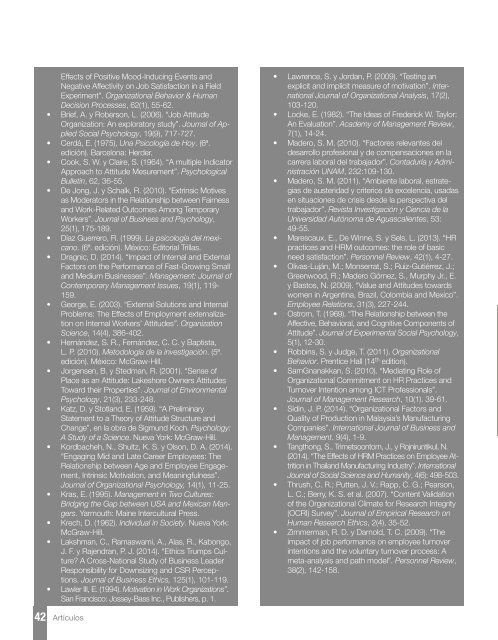ConSciencia Digital 2
You also want an ePaper? Increase the reach of your titles
YUMPU automatically turns print PDFs into web optimized ePapers that Google loves.
42<br />
Effects of Positive Mood-Inducing Events and<br />
Negative Affectivity on Job Satisfaction in a Field<br />
Experiment”. Organizational Behavior & Human<br />
Decision Processes, 62(1), 55-62.<br />
• Brief, A. y Roberson, L. (2006). “Job Attitude<br />
Organization: An exploratory study”. Journal of Applied<br />
Social Psychology, 19(9), 717-727.<br />
• Cerdá, E. (1975), Una Psicología de Hoy. (6ª.<br />
edición). Barcelona: Herder.<br />
• Cook, S. W. y Claire, S. (1964). “A multiple Indicator<br />
Approach to Attitude Mesurement”. Psychological<br />
Bulletin, 62, 36-55.<br />
• De Jong, J. y Schalk, R. (2010). “Extrinsic Motives<br />
as Moderators in the Relationship between Fairness<br />
and Work-Related Outcomes Among Temporary<br />
Workers”. Journal of Business and Psychology,<br />
25(1), 175-189.<br />
• Díaz Guerrero, R. (1999). La psicología del mexicano.<br />
(6ª. edición). México: Editorial Trillas.<br />
• Dragnic, D. (2014). “Impact of Internal and External<br />
Factors on the Performance of Fast-Growing Small<br />
and Medium Businesses”. Management: Journal of<br />
Contemporary Management Issues, 19(1), 119-<br />
159.<br />
• George, E. (2003). “External Solutions and Internal<br />
Problems: The Effects of Employment externalization<br />
on Internal Workers’ Attitudes”. Organization<br />
Science, 14(4), 386-402.<br />
• Hernández, S. R., Fernández, C. C. y Baptista,<br />
L. P. (2010). Metodología de la investigación. (5ª.<br />
edición). México: McGraw-Hill.<br />
• Jorgensen, B. y Stedman, R. (2001). “Sense of<br />
Place as an Attitude: Lakeshore Owners Attitudes<br />
Toward their Properties”. Journal of Environmental<br />
Psychology, 21(3), 233-248.<br />
• Katz, D. y Stotland, E. (1959). “A Preliminary<br />
Statement to a Theory of Attitude Structure and<br />
Change”, en la obra de Sigmund Koch. Psychology:<br />
A Study of a Science. Nueva York: McGraw-Hill.<br />
• Kordbacheh, N., Shultz, K. S. y Olson, D. A. (2014).<br />
“Engaging Mid and Late Career Employees: The<br />
Relationship between Age and Employee Engagement,<br />
Intrinsic Motivation, and Meaningfulness”.<br />
Journal of Organizational Psychology, 14(1), 11-25.<br />
• Kras, E. (1995). Management in Two Cultures:<br />
Bridging the Gap between USA and Mexican Mangers.<br />
Yarmouth: Maine Intercultural Press.<br />
• Krech, D. (1962). Individual in Society. Nueva York:<br />
McGraw-Hill.<br />
• Lakshman, C., Ramaswami, A., Alas, R., Kabongo,<br />
J. F. y Rajendran, P. J. (2014). “Ethics Trumps Culture?<br />
A Cross-National Study of Business Leader<br />
Responsibility for Downsizing and CSR Perceptions.<br />
Journal of Business Ethics, 125(1), 101-119.<br />
• Lawler III, E. (1994). Motivation in Work Organizations”.<br />
San Francisco: Jossey-Bass Inc., Publishers, p. 1.<br />
Artículos<br />
• Lawrence, S. y Jordan, P. (2009). “Testing an<br />
explicit and implicit measure of motivation”. International<br />
Journal of Organizational Analysis, 17(2),<br />
103-120.<br />
• Locke, E. (1982). “The Ideas of Frederick W. Taylor:<br />
An Evaluation”. Academy of Management Review,<br />
7(1), 14-24.<br />
• Madero, S. M. (2010). “Factores relevantes del<br />
desarrollo profesional y de compensaciones en la<br />
carrera laboral del trabajador”. Contaduría y Administración<br />
UNAM, 232:109-130.<br />
• Madero, S. M. (2011). “Ambiente laboral, estrategias<br />
de austeridad y criterios de excelencia, usadas<br />
en situaciones de crisis desde la perspectiva del<br />
trabajador”. Revista Investigación y Ciencia de la<br />
Universidad Autónoma de Aguascalientes, 53:<br />
49-55.<br />
• Marescaux, E., De Winne, S. y Sels, L. (2013). “HR<br />
practices and HRM outcomes: the role of basic<br />
need satisfaction”. Personnel Review, 42(1), 4-27.<br />
• Olivas-Luján, M.; Monserrat, S.; Ruiz-Gutiérrez, J.;<br />
Greenwood, R.; Madero Gómez, S., Murphy Jr., E.<br />
y Bastos, N. (2009). “Value and Attitudes towards<br />
women in Argentina, Brazil, Colombia and Mexico”.<br />
Employee Relations, 31(3), 227-244.<br />
• Ostrom, T. (1969). “The Relationship between the<br />
Affective, Behavioral, and Cognitive Components of<br />
Attitude”. Journal of Experimental Social Psychology,<br />
5(1), 12-30.<br />
• Robbins, S. y Judge, T. (2011). Organizational<br />
Behavior. Prentice Hall (14 th edition).<br />
• SamGnanakkan, S. (2010). “Mediating Role of<br />
Organizational Commitment on HR Practices and<br />
Turnover Intention among ICT Professionals”.<br />
Journal of Management Research, 10(1). 39-61.<br />
• Sidin, J. P. (2014). “Organizational Factors and<br />
Quality of Production in Malaysia’s Manufacturing<br />
Companies”. International Journal of Business and<br />
Management. 9(4), 1-9.<br />
• Tangthong, S., Trimetsoontorn, J., y Rojniruntikul, N.<br />
(2014). “The Effects of HRM Practices on Employee Attrition<br />
in Thailand Manufacturing Industry”. International<br />
Journal of Social Science and Humanity, 4(6): 498-503.<br />
• Thrush, C. R.; Putten, J. V.; Rapp, C. G.; Pearson,<br />
L. C.; Berry, K. S. et al. (2007). “Content Validation<br />
of the Organizational Climate for Research Integrity<br />
(OCRI) Survey”. Journal of Empirical Research on<br />
Human Research Ethics, 2(4), 35-52.<br />
• Zimmerman, R. D. y Darnold, T. C. (2009). “The<br />
impact of job performance on employee turnover<br />
intentions and the voluntary turnover process: A<br />
meta-analysis and path model”. Personnel Review,<br />
38(2), 142-158.















